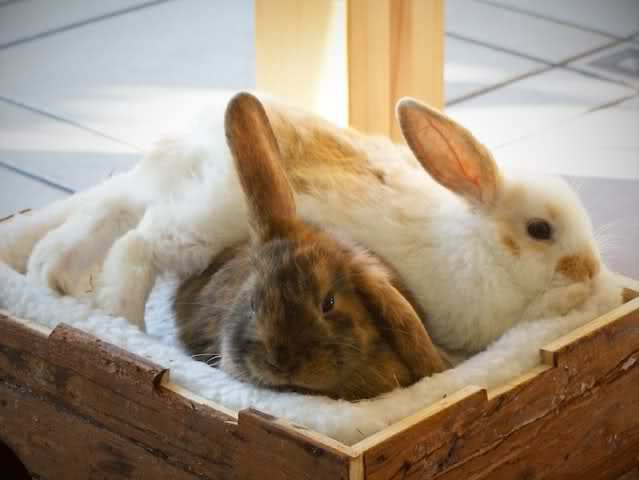
Contents
- What can happen during the bonding process and what can I do?
- Typical bonding process
- A Matter of Smell!
- The neutral environment
- Examples for bonding places
- How much space do they need?
- Enrichment
- Setting them down simultaneously
- Smelling each other
- Humping each other
- Chasing and pulling fur
- Resting from exhaustion
- Jumping
- Defending the Toilet or Enclosure Area (Territorial Behavior)
- Retract, Retreat
- Submission
- Getting closer
- Eating next to each other
- Moving to their home base
- Attention: Large Enclosures!
- How long is it going to take until your rabbits are bonded?
- Cuddling
- Special behaviour
- Circling, Fighting, biting
- Constant chasing
- Urine spills, uncleanness
- Withdrawing anxiously
- Nothing happens
- Bite marks
- Chronic biters
What can happen during the bonding process and what can I do?
It’s never too late to get a friend for your existing rabbit. There are many cases where older rabbits have spent their twilight years happily with a new companion.
Typical bonding process
Let’s assume the following:
- The bonding process happens on neutral territory (a place none of the rabbits have ever been on).
- You checked beforehand if the rabbits are likely to be compatible. Please note that young rabbits that are under 16 weeks old should not be bonded easily with older rabbits.
Important: Bonding a group of rabbits with 4 or more rabbits should be performed by experienced rabbit keepers as group bonding is more complex and intense rather than bonding 2 – 3 rabbits.
Important: Bonding is very stressful, and especially with larger groups, it may sometimes fail. Therefore, do not subject your rabbits to unnecessary introductions. A well-functioning group should not be jeopardized.
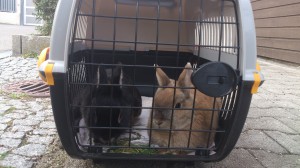
Preparations for the animals
Check the health status of all the rabbits beforehand. Before the bonding
process starts make sure to do a stool sample and check it for any parasites
and also check their E.Cuniculi status in their blood. EC-positive rabbits
should only be bonded with other EC-positive rabbits and vice versa
(EC-negative rabbits with EC-negative rabbits) so that no new rabbits are getting
infected.
If you have the chance you can stress your rabbits a little bit by driving them
around with your car but make sure they are in separate boxes if they
haven’t met each other yet!
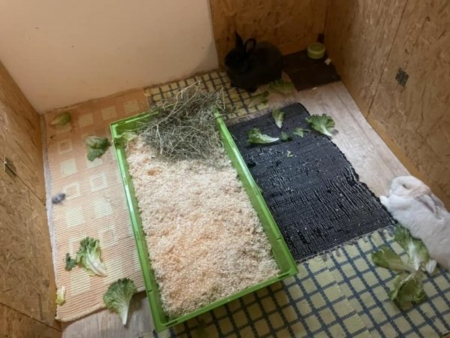
The most ideal time to bond them is during lunchtime around early afternoon as it is the time they are the least active and most calm. The best season for bonding is winter because hormones play a smaller role during that time. Even neutered rabbits have hormones. If your rabbit is alone, it should be bonded with a companion as soon as possible, regardless of the current season.
Remember that bonded rabbits should be together all the time. Do not separate them during the night or for other similar reasons.
A Matter of Smell!
In rabbits, group affiliation is communicated through scent, meaning a rabbit with a foreign scent may be rejected. To support bonding, you can alternate stroking the rabbits before the introduction and/or rub them with bedding from the other rabbit to develop a group scent. Later, this shared scent develops through cuddling, body contact, and shared surroundings.

The neutral environment
Attention! Bonding rabbits on non-neutral territory (meaning at least one rabbit has been in that territory and therefore marked it already) can lead to severe or even life threatening injuries!

Choose a space none of your rabbits have ever been in (disinfecting and rearranging furniture is not enough, your rabbit will still recognize the space!). Remember that the rabbits are not potty trained during the bonding process but still need enough friction on the ground (carpets, lawn, stone slabs). Slippery floors must be avoided. The rabbits have to be able to stay in that territory for a few days or even weeks until the bonding process is over.

Examples for bonding places
Often times is it not easy to find a place, that the rabbits have not seen, protects them from any predators like racoons and is also large enough.
Recommendations:
- basements
- Garages
- Summer houses
- Storage rooms
- Washrooms
- Tool sheds
- Balconies
- Bathrooms, kitchen
- Asking friends/relatives/ neighbors
- In an animal pension whose employees are familiar with bonding rabbits
- At other rabbit keepers
- Empty swimming pools
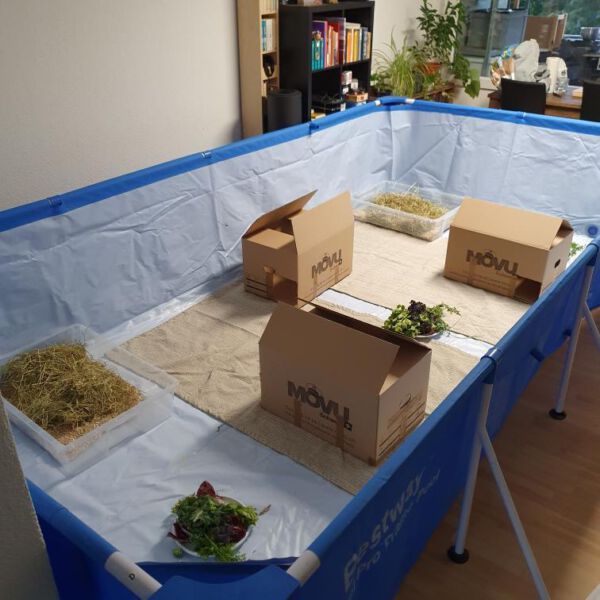
How much space do they need?
The neutral area should not be too large. As a rule of thumb, you can calculate 1-2m² + 1m² per rabbit, so 3-4m² for two rabbits. If the space is too large, territories are often formed, leading to the failure of the bonding process.
Enrichment
Design the bonding area with clarity; too much enrichment can jeopardize the bonding process as the rabbits may withdraw too much. Avoid platforms or roofed hideouts. You can offer willow bridges. Rabbits love piles of hay. Never use anything they are already familiar with. At least 2 entrances are necessary to prevent dead-end situations and provide space where the rabbits can run in circles. Rabbit houses and similar structures must be closed off to prevent any rabbit from retreating inside. Choose items with low risk of injury; sharp edges, for example, could lead to bruising.
Rabbits are very territorial and any competition for resources might cause tension so ensure you have at least one of feeding place and water bowl for each rabbit.

Setting them down simultaneously
Rabbits have to be let into the bonding space at the same time. It’s okay if there is a bit of a time delay (seconds don’t matter) as long as one rabbit hasn’t had the time to explore the territory on its own yet.
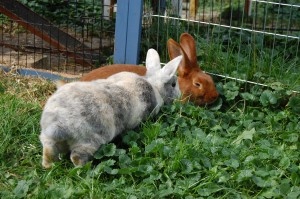
Smelling each other
With tilted ears they start to smell each other in order to get to know each other slowly.
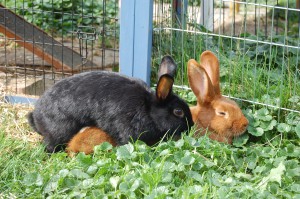
Humping each other
Humping each other is NOT sexual but helps them to define their hierarchy. Anyone who is on top wants to be dominant, the one that is getting humped ranks themselves lower.

Chasing and pulling fur
This is also completely normal so please do not interrupt.
Please note: Dead ends like hiding spots with only one entrance must be avoided, because that can lead to a rabbit being trapped by the other. Provide running circles so the rabbits can chase each other.
Do not bond them in the space they are going to live after the bonding process but leave them in the neutral space. They will slowly stop chasing each other and even if they are chasing each other a lot this will dial down as well.
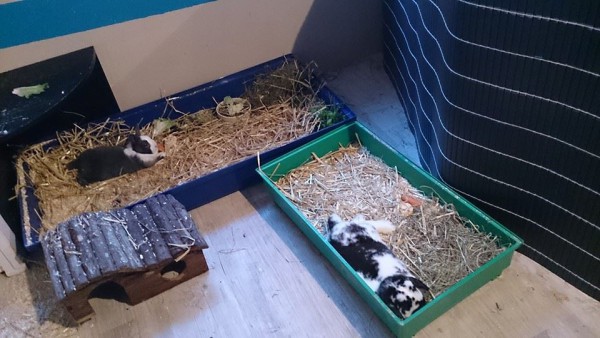
Resting from exhaustion
After the rabbits chased each other for a long period of time they need food and recovery breaks and will lay down in different corners of the space. Bonding is exhausting. Make sure your rabbits don’t chase each other continuously and take breaks. Do not separate them though but provide shadow and hiding spots so they do not get too exhausted.
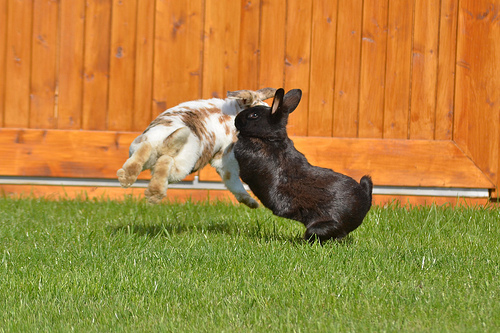
Jumping
Rabbits often jump/hop around during the bonding process, either passed each other or towards each other in the air. This behavior is normal.

Defending the Toilet or Enclosure Area (Territorial Behavior)
Rabbits are very territorial, and some may begin to establish territories in the neutral enclosure, leading to potential failure of the bonding process! An invisible line is formed, and if crossed, the rabbit claiming the territory will chase away the other. In such cases, the enclosure should be reduced in size so that the defended territory is no longer within the enclosure. It is also common for rabbits to defend cage trays. If noticed early, it is best to push them to the center of the enclosure. If the defense persists, they should be replaced with something flat (e.g., shoe trays or smaller litter boxes).
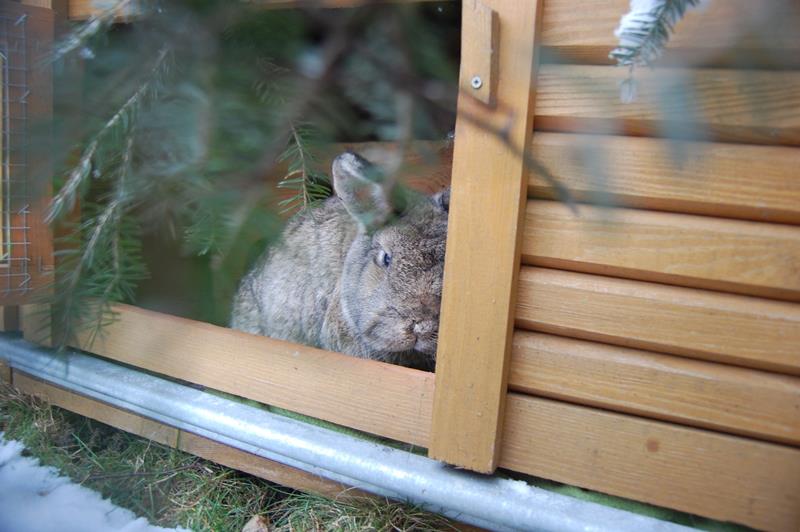
Retract, Retreat
If your rabbits start to anticipate and avoid bonding with the other rabbit(s) by hiding somewhere else you have to intervene.
A rabbit who is not just taking breaks but actively avoids bonding with other rabbits will likely make the bonding process fail. Place the rabbit back to the other rabbit and close the retreat off. Providing hiding spots with at least two entrances in the main area is important though.
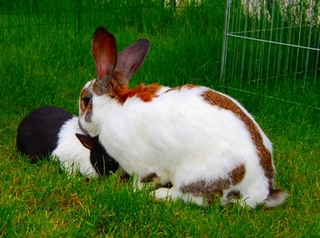
Submission
The defeated animal usually submits after a while by laying its head flat on the ground and does not run away. The dominant animal then humps or cleans it.

Getting closer
After a while the rabbits are going to physically get closer. This can take a while though.

Eating next to each other
Once the rabbits have determined their ranking and start to like each other they will eat next to each other.
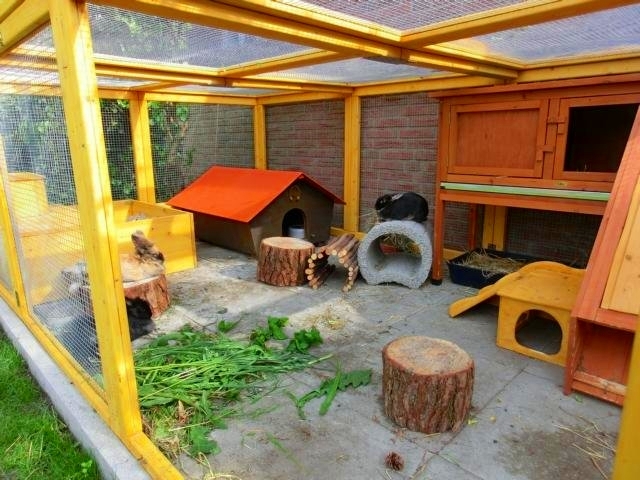
Moving to their home base
Once the rabbits stop chasing each other, you should wait another 2 to 3 days until you move them to their originally intended home base. You should wait at least 5 days overall until you move them even though they seem to like each other already. Make sure that there are no dead ends and rearrange any furniture accordingly. You don’t need to disinfect the area! It is possible that your rabbits start to chase each other again once they have been moved but this will dial down pretty fast and is harmless. If they start to fight again you need to move them back to their neutral space. You might have stopped the bonding process too early!
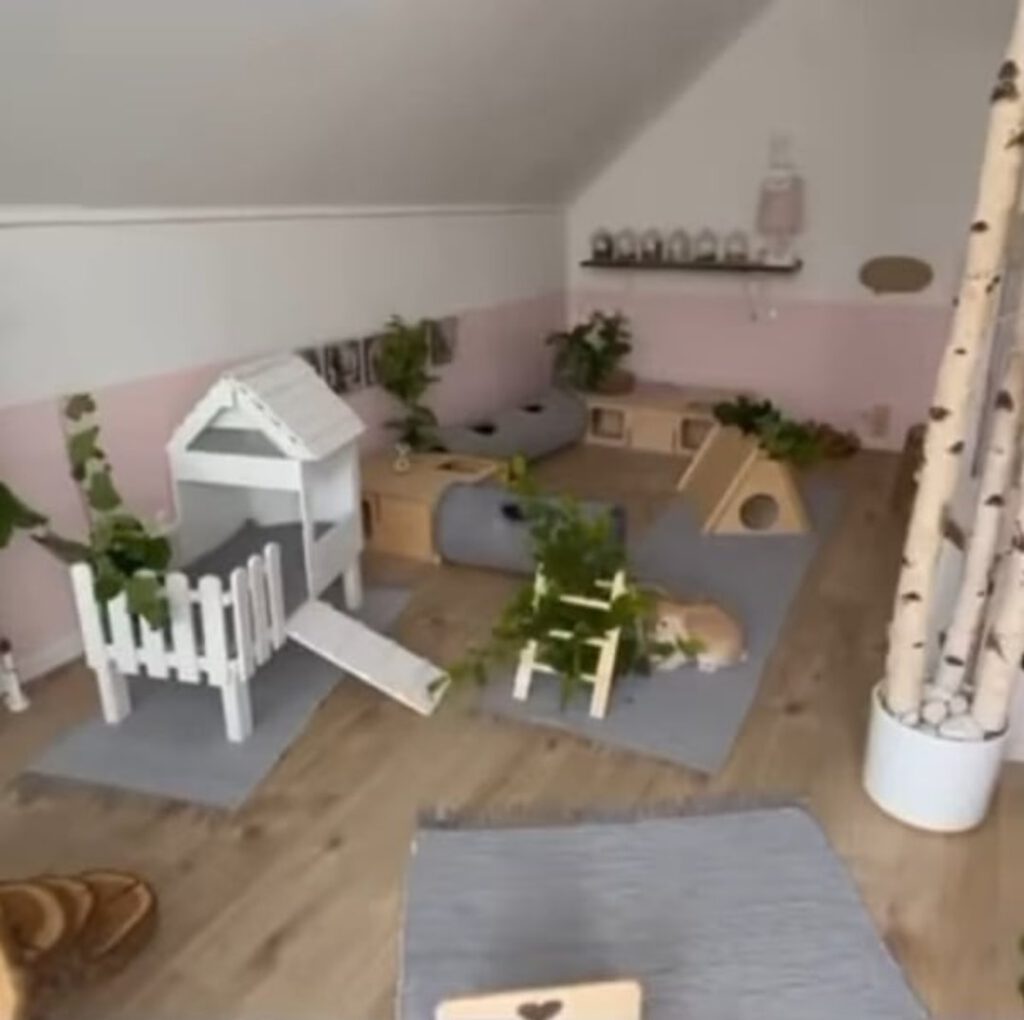
Attention: Large Enclosures!
Do your rabbits live in free-range indoor housing? Do they have a very large enclosure or garden space? In this case, rabbits often establish territories when returned from the bonding enclosure to their home territory! This can be avoided by gradually expanding the territory, for example, initially fencing off a portion of the enclosure, then making the entire enclosure or room accessible, and opening a portion of the outdoor space weeks later. If there are fights, the rabbits ignore each other, establish territories, or exclude individuals, you have proceeded too quickly!

How long is it going to take until your rabbits are bonded?
Rabbits each have different personalities. That is why it is difficult to say how long it is going to take. Usually you can assume the following though. There are exceptions where the bonding process takes a lot longer:
- Smooth pair bonding: 7-10 days
- Groups of 3: 10-12 days
- Larger groups: 2-3 weeks
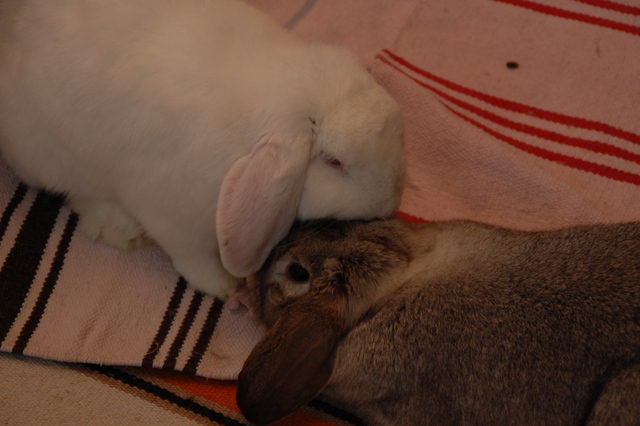
Cuddling
It is hard to tell when your rabbits start to cuddle. Some cuddle after only a day, some need months. There are also rabbits that do not like to cuddle at all.
Special behaviour
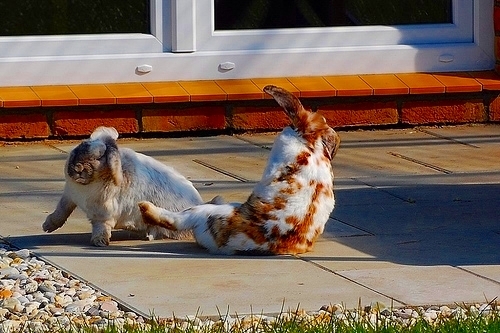
Circling, Fighting, biting
If you notice your rabbits getting tangled into each other because one bites the other and vice versa, make sure to separate them by using any object (e. g. sweeper, not your hand!). Try to untangle them. Biting is imminent when the rabbits circle each other, attempting to bite the hindquarters of the other rabbit while spinning in circles. It is best to intervene at that point! Be patient, this happens usually maybe 1 or 2 times in the beginning. In case they are getting tangled constantly they might not be suitable for each other and you have to look for another partner. This happens usually with poorly chosen group compositions or with poorly socialized animals.

Constant chasing
The rabbits are chasing each other constantly and it doesn’t seem like they are going to stop? If that happens over a course of hours with occasional breaks it still counts as normal behavior. If an animal is still getting chased after two weeks, can’t really take breaks and is anxious the whole time you need to separate them and find another more suitable partner. Some rabbits are not suitable for larger groups or are overly anxious. It is better for them to be bonded with only one partner of the opposite sex.

Urine spills, uncleanness
Urine spills are common especially amongst unneutered rabbits. During the bonding process the rabbits mark their territory with urine or their poop. Therefore, they are not housebroken at this stage. This will get better once they are tamer. Inharmonious or large groups are often not housebroken and are therefore not suitable for indoor keeping.
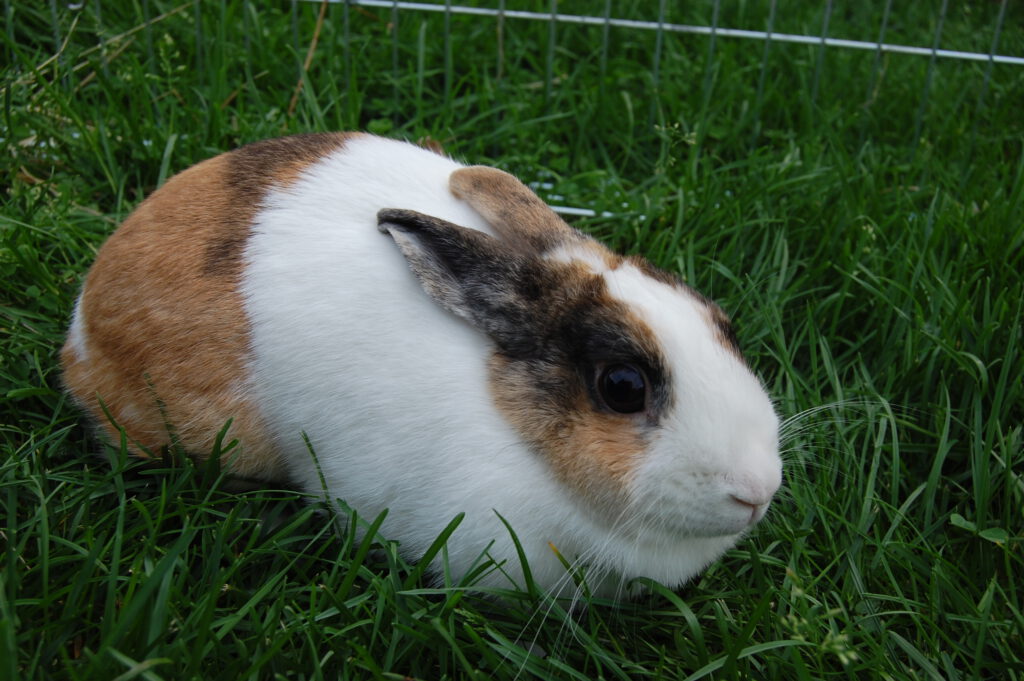
Withdrawing anxiously
If a rabbit sits in a corner with wide eyes, doesn’t engage in the bonding process and doesn’t move (puts up with everything, doesn’t eat, etc.), it’s very scared. Reasons might be due to its character or previous bad experiences. They can still be scared even if the other rabbit doesn’t actually do anything. Or the other rabbit submits to the other which is normal during the bonding process. If one rabbit chases the other rabbit vigorously though and bites, causing wounds, then the bonding process should be stopped. Look for another sensitive and calm partner of the opposite sex. Your rabbit might not be suitable for large groups or its partner is too dominant. In extreme cases the scared rabbit turns it heads towards the wall, doesn’t move, doesn’t eat and lets the other rabbit bite them.

Nothing happens
There are bonding cases in which nothing happens. The rabbits pretend like there is no other rabbit in the territory. Caution is advised with bonding cases like this, as hierarchy fights often start later after several days or weeks and are then all the more severe because the enclosure is then no longer neutral. These are often bonding processes that fail. In rare cases though there are rabbits that simply accept each other.
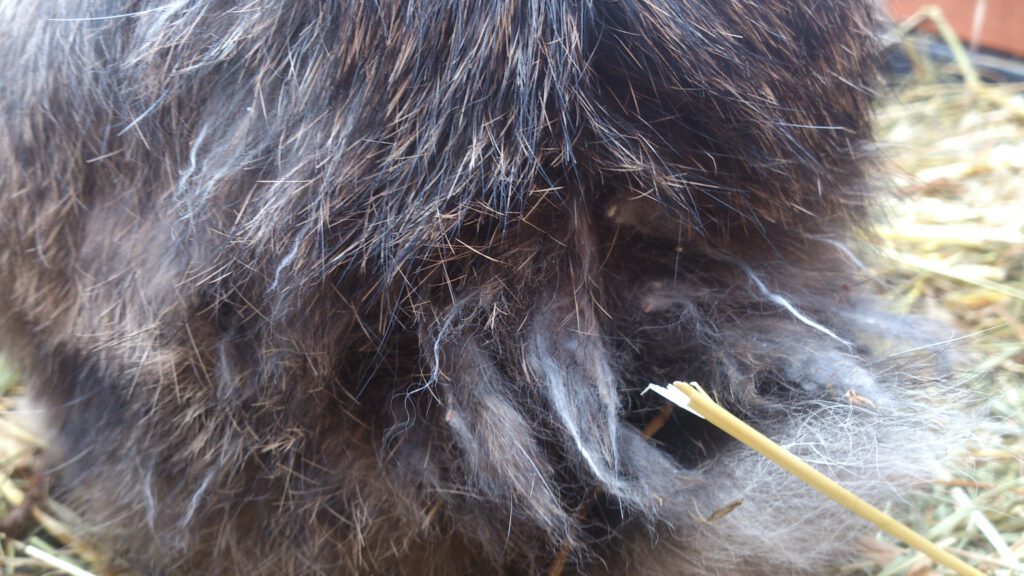
Bite marks
Your rabbits might get bite marks all over their body. It is important to check on them regularly whether they are severly injured or not. If they have multiple large bite marks we recommend to stop the bonding process and find another more suitable partner (similar of age and opposite sex). If there are only a few bite marks and light scratches, your rabbits are going to be fine. Injuries sometimes happen by accident (e. g. while they are jumping at each other). While they can get eye injuries you should also pay attention to ear and nose injuries esspecially when it comes to lop rabbits. Please note that severe bite marks are rare.

Chronic biters
There are rabbits that constantly bite other rabbits during the bonding process. This can have various causes and needs to be assessed differently. For example it is still considered normal behaviour is a rabbit attacks the back/butt of another rabbit! Rabbits that bite anything that looks like a rabbit and comes near them are usually very scared and try to protect themselves. For these animals you should choose a calm, well-balanced animal that is not impressed by their actions and still seeks contact or stays in the environment. Over time, the rabbit gets used to the other and bites less and eventually not at all. But there are also rabbits that chase and bites other rabbits because they don’t like them. If the other rabbit has multiple and/or more severe bite injuries, the rabbits are simply not compatible. Try a similarly-aged, opposite-sex rabbit as a partner.
